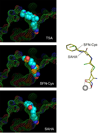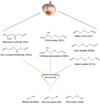Modulation of histone deacetylase activity by dietary isothiocyanates and allyl sulfides: studies with sulforaphane and garlic organosulfur compounds
- PMID: 19197985
- PMCID: PMC2701665
- DOI: 10.1002/em.20454
Modulation of histone deacetylase activity by dietary isothiocyanates and allyl sulfides: studies with sulforaphane and garlic organosulfur compounds
Abstract
Histone deacetylase (HDAC) inhibitors reactivate epigenetically-silenced genes in cancer cells, triggering cell cycle arrest and apoptosis. Recent evidence suggests that dietary constituents can act as HDAC inhibitors, such as the isothiocyanates found in cruciferous vegetables and the allyl compounds present in garlic. Broccoli sprouts are a rich source of sulforaphane (SFN), an isothiocyanate that is metabolized via the mercapturic acid pathway and inhibits HDAC activity in human colon, prostate, and breast cancer cells. In mouse preclinical models, SFN inhibited HDAC activity and induced histone hyperacetylation coincident with tumor suppression. Inhibition of HDAC activity also was observed in circulating peripheral blood mononuclear cells obtained from people who consumed a single serving of broccoli sprouts. Garlic organosulfur compounds can be metabolized to allyl mercaptan (AM), a competitive HDAC inhibitor that induced rapid and sustained histone hyperacetylation in human colon cancer cells. Inhibition of HDAC activity by AM was associated with increased histone acetylation and Sp3 transcription factor binding to the promoter region of the P21WAF1 gene, resulting in elevated p21 protein expression and cell cycle arrest. Collectively, the results from these studies, and others reviewed herein, provide new insights into the relationships between reversible histone modifications, diet, and cancer chemoprevention.
Figures



Similar articles
-
Allyl mercaptan, a garlic-derived organosulfur compound, inhibits histone deacetylase and enhances Sp3 binding on the P21WAF1 promoter.Carcinogenesis. 2008 Sep;29(9):1816-24. doi: 10.1093/carcin/bgn165. Epub 2008 Jul 14. Carcinogenesis. 2008. PMID: 18628250 Free PMC article.
-
Dietary histone deacetylase inhibitors: from cells to mice to man.Semin Cancer Biol. 2007 Oct;17(5):363-9. doi: 10.1016/j.semcancer.2007.04.001. Epub 2007 May 5. Semin Cancer Biol. 2007. PMID: 17555985 Free PMC article. Review.
-
A novel mechanism of chemoprotection by sulforaphane: inhibition of histone deacetylase.Cancer Res. 2004 Aug 15;64(16):5767-74. doi: 10.1158/0008-5472.CAN-04-1326. Cancer Res. 2004. PMID: 15313918
-
Modulation of histone acetylation by garlic sulfur compounds.Anticancer Agents Med Chem. 2011 Mar;11(3):254-9. doi: 10.2174/187152011795347540. Anticancer Agents Med Chem. 2011. PMID: 21269249 Review.
-
Differential effects of sulforaphane on histone deacetylases, cell cycle arrest and apoptosis in normal prostate cells versus hyperplastic and cancerous prostate cells.Mol Nutr Food Res. 2011 Jul;55(7):999-1009. doi: 10.1002/mnfr.201000547. Epub 2011 Mar 4. Mol Nutr Food Res. 2011. PMID: 21374800 Free PMC article.
Cited by
-
Sulforaphane prevents angiotensin II-induced cardiomyopathy by activation of Nrf2 through epigenetic modification.J Cell Mol Med. 2021 May;25(9):4408-4419. doi: 10.1111/jcmm.16504. Epub 2021 Apr 1. J Cell Mol Med. 2021. PMID: 33793066 Free PMC article.
-
Non-coding RNA/microRNA-modulatory dietary factors and natural products for improved cancer therapy and prevention: Alkaloids, organosulfur compounds, aliphatic carboxylic acids and water-soluble vitamins.Noncoding RNA Res. 2016 Sep 3;1(1):51-63. doi: 10.1016/j.ncrna.2016.09.001. eCollection 2016 Oct. Noncoding RNA Res. 2016. PMID: 30159411 Free PMC article. Review.
-
Sulforaphane represses matrix-degrading proteases and protects cartilage from destruction in vitro and in vivo.Arthritis Rheum. 2013 Dec;65(12):3130-40. doi: 10.1002/art.38133. Arthritis Rheum. 2013. PMID: 23983046 Free PMC article.
-
Epidemiological transition of colorectal cancer in developing countries: environmental factors, molecular pathways, and opportunities for prevention.World J Gastroenterol. 2014 May 28;20(20):6055-72. doi: 10.3748/wjg.v20.i20.6055. World J Gastroenterol. 2014. PMID: 24876728 Free PMC article. Review.
-
Epigenetic Contributions to the Relationship between Cancer and Dietary Intake of Nutrients, Bioactive Food Components, and Environmental Toxicants.Front Genet. 2012 Jan 9;2:91. doi: 10.3389/fgene.2011.00091. eCollection 2011. Front Genet. 2012. PMID: 22303385 Free PMC article.
References
-
- Chung YL, Lee MY, Wang AJ, Yao LF. A therapeutic strategy uses histone deacetylase inhibitors to modulate the expression of genes involved in the pathogenesis of rheumatoid arthritis. Mol Ther. 2003;8(5):707–717. - PubMed
Publication types
MeSH terms
Substances
Grants and funding
LinkOut - more resources
Full Text Sources
Other Literature Sources
Research Materials
Miscellaneous

